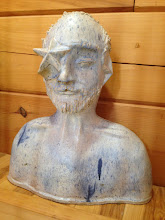The pots that were going to be fired from the last post were hijacked over to Rob's wood kiln and fired there. I got hijacked to do some engineering work so the kiln - and the blog - has sat waiting. Yesterday, I finally fired the kiln.
This was the kiln's first cone 10 firing. I have been thinking about moving to the cone 6 to 7 range (lower temperature) to save fuel and wear and tear on the kiln. It has been a debate going on in my head for quite some time. On the plus side is the savings in time, money and being slightly more "green" (if potters can be considered at all green in their processes). On the minus side is the change in glazes, experimentation required, and adjustments to aesthetics that are needed to shift from what I have been doing at cone 10. I think in the end I will make the shift, but in true Jody fashion, I will ponder it for a while longer.
However, I did want to prove that the kiln could fire to cone 10. That was the design temperature I set. The guy who sold me the burners for the kiln, advised that the kiln might not be able to make it to temperature and suggested bigger burners. I redid my numbers, checked them twice and stuck with the smaller burners (which are pretty damn big to begin with). But... I used to stand on the deck of the launch barge offshore, ready to push the structure off the barge into the water after 9 months of engineering and wonder, will it realy float like I calculated it would? They always did, but until it was out there bobbing in the sea, I kept running through the numbers in my head. So, at least once, I had to go to the design temperature of cone 10.
It made it no problem. In fact, I had to hold the burners back.
Kiln opening will be Friday. My youngest daughter is coming for a visit on her way back to Texas so I will wait until she is here.



























